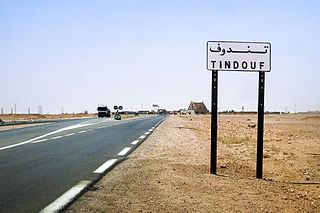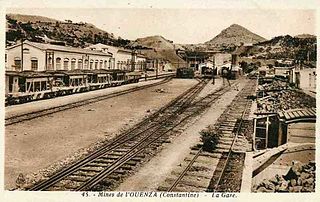
Iron ores are rocks and minerals from which metallic iron can be economically extracted. The ores are usually rich in iron oxides and vary in color from dark grey, bright yellow, or deep purple to rusty red. The iron is usually found in the form of magnetite (Fe
3O
4, 72.4% Fe), hematite (Fe
2O
3, 69.9% Fe), goethite (FeO(OH), 62.9% Fe), limonite (FeO(OH)·n(H2O), 55% Fe) or siderite (FeCO3, 48.2% Fe).

Annaba, formerly known as Bon, Bona and Bône, is a seaport city in the northeastern corner of Algeria, close to the border with Tunisia. Annaba is near the small Seybouse River and is in the Annaba Province. With a population of about 464,740 (2019) and 1,000,000 for the metropolitan area, Annaba is the third-largest city and the leading industrial center in Algeria.

Tébessa is a province (wilayah) of Algeria. Tébessa is also the name of the capital, which in ancient times it was known as Theveste. Another important city is El Ouenza. Tébessa is located only 20 kilometers west of the Tunisian border.
The following is a list of Registered Historic Places in Iron County, Michigan. The list includes 79 structures and historic districts that are significant for their architectural, historical, or industrial/economic importance.

The Lake Vermilion-Soudan Underground Mine State Park is a Minnesota state park at the site of the Soudan Underground Mine, on the south shore of Lake Vermilion, in the Vermilion Range (Minnesota). The mine is known as Minnesota's oldest, deepest, and richest iron mine. It formerly hosted the Soudan Underground Laboratory. As the Soudan Iron Mine, it has been designated a U.S. National Historic Landmark.
Opération Lamantin was a December 1977 – July 1978 military intervention by France on the behalf of the Mauritanian government, in its war against Sahrawi guerrilla fighters of the Polisario Front, seeking independence for Western Sahara. Airstrikes were launched in the provinces with the aim of stopping separatist raids in the rail route from the iron mines in Zouérat to the coast of Nouadhibou, and pushing them to release French hostages. France used Jaguar combat aircraft from Dakar Airbase. The bombings targeted areas around the railway, which was constantly raided by Polisario. The mission ended with the release of the hostages and the halt of Polisario's attacks on ore cargo.
Iron ore production in Africa is dominated by South Africa, Mauritania and Algeria. Many countries possess iron ore deposits that are as yet untapped/unmined. Countries and companies currently involved in production are listed here; measurements are in tonnes per annum(year).

Beni Saf is a town in northwestern Algeria, about 80 kilometers southwest of Oran. The town was founded in 1876 as a shipping port for iron ore, which is mined just south of the town. Other products of the town include zinc, marble and onyx, and the fishing industry is extensive.
Hydrocarbons are the leading sector in Algeria's mineral industry, which includes diverse but modest production of metals and industrial minerals. In 2006, helium production in Algeria accounted for about 13% of total world output. Hydrocarbons produced in Algeria accounted for about 2.9% of total world natural gas output and about 2.2% of total world crude oil output in 2006. Algeria held about 21% of total world identified resources of helium, 2.5% of total world natural gas reserves, and about 1% of total world crude oil reserves.

Ferrexpo plc is a Swiss-based commodity trading and mining company which is the third largest exporter of iron ore pellets in the world. Ferrexpo's operating base is in central Ukraine, where it operates three iron-ore mines and an iron ore pellet production facility. The company's trading office is located in London where it is listed on the London Stock Exchange and it is a constituent of the FTSE 250 Index and FTSE4Good Index.
The second-largest mineral industry in the world is the mineral industry of Africa, which implies large quantities of resources due to Africa being the second largest continent, with 30.37 million square kilometres of land.With a population of 1.4 billion living there, mineral exploration and production constitute significant parts of their economies for many African countries and remain keys to economic growth. Africa is richly endowed with mineral reserves and ranks first in quantity of world reserves for bauxite, cobalt, industrial diamond, phosphate rock, platinum-group metals (PGM), vermiculite, and zirconium.
Uranium production is an important part of the African economy, with Niger, Namibia and South Africa creating up to 18% of the world's annual production. Many African countries produce uranium or have untapped uranium ore deposits.

Jérissa, also El-Jarissa, is a town and commune in the Kef Governorate, Tunisia. As of 2004 it had a population of 11,298. It is located 51.7 kilometres (32.1 mi) by road east of the Algerian town of Ouenza.

Boukhadra is a town and commune in Tébessa Province in north-eastern Algeria.
This lists of mines is a meta-list containing links to mine-related lists.

The Gâra Djebilet mine is an iron mine located in Tindouf Province in western Algeria which entered into operation in July 2022. It represents one of the largest iron ore reserves in the world. Its reserves are estimated at 3.5 billion tons, of which 1.7 billion tons are exploitable.

The mining industry of Tunisia focuses mainly on phosphate products such as fertilizer, industrial minerals, iron ore, and salt. Mine ownership is limited to the Government of Tunisia, although operation by private entities is encouraged.

The Société Mokta El Hadid was an iron ore mining company in Algeria, and later in other West African countries. From around 1865 until 1927 it was the largest mining company in Algeria, delivering ore of exceptional quality for processing in France. In 1878 the original Mokta El Hadid mine near Bône was said to be capable of supporting 25% of Europe's steel production. Before this mine was exhausted the company opened additional mines in Algeria. Later it extended its operations to countries such as Tunisia, Morocco, Niger, Côte-d'Ivoire and Madagascar, and mined manganese, chromium and uranium. In October 1970 the Société le Nickel, soon to become the Imétal holding company, took over the Mokta company. The company was later renamed Compagnie française de Mokta (CFM), specializing in uranium mining.

Denain-Anzin was a steel manufacturer in Denain and Anzin in the Nord department of France. The company was created through the merger of two smaller forges to produce rails for the Nord railway company. After World War II it was merged with other companies in 1948 to form Usinor.

The Société de l'Ouenza was an Algerian iron ore mining company founded in 1913 and nationalized in 1966. It exploited rich deposits of high-quality ore at two sites in northeast Algeria near the Tunisian border. The ore was sent by rail to the port of Bône, then shipped to refineries in the UK, Europe and North America. At its peak it employed 4,000 workers who were housed in company towns.












